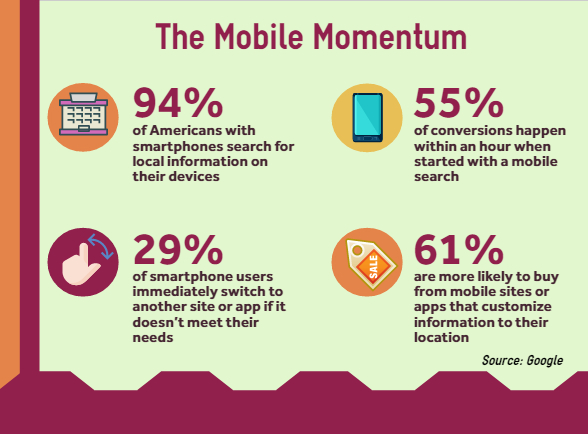 Back in 2016, Google announced it was updating its search results algorithms to give preference to sites that are optimized for mobile. This wasn’t just an informational notice to the masses; it was a subtle warning for businesses to improve their sites’ usability and relevance by becoming mobile-friendly – or risk falling in search result rankings.
Back in 2016, Google announced it was updating its search results algorithms to give preference to sites that are optimized for mobile. This wasn’t just an informational notice to the masses; it was a subtle warning for businesses to improve their sites’ usability and relevance by becoming mobile-friendly – or risk falling in search result rankings.
Why the focus on the mobile experience? Research conducted by Google and other partners show mobile devices are an important part of people’s lives. In fact, according to Google, 77% of mobile searches happen at home or at work, places where desktop computers are most likely available. So people are choosing to use their phone or tablet over a computer to find information, make a purchase and engage with others.
Here’s more Google research to justify going mobile:

In order to keep up with the huge rise in mobile users, Google has concentrated its efforts on making the web more mobile-friendly for people. They’ve created informative guides, developed website tests and started community forums to help businesses and website owners build a mobile-friendly site and better overall experience for visitors.
Becoming mobile-friendly
So what does your business need to do to provide a great mobile experience? First and foremost, build a responsive site. A responsive design utilizes just one website and URL, and ensures your website’s content, images and overall layout look the same on any device a buyer uses. Considered an industry best practice by Google, a responsive web design not only makes it easier for Google to scan, index and organize the online content, but it also allows users to share content and interact with you.
Once your responsive site is in place, there are a host of things you should do (and not do) to optimize your site for mobile users:
What helps the mobile experience:
- Text that is easy to read without having to zoom
- Large buttons and links that are far enough apart so that a user doesn’t have trouble clicking on them
- Relevant images that enhance your content and leave a positive impression
- Fast-loading pages with the help of AMPs (accelerated mobile pages), which can make pages load up to 30 times faster
- Enabled GPS capabilities so customers can see local product availability and utilize GPS-powered directions to your brick and mortar stores
What hinders the mobile experience:
- Software that’s not mobile-friendly, like Flash for videos
- Technical errors such as faulty redirects leading to the site’s desktop version and non-existing pages
- Text-heavy pages that clutter the screen and make it difficult for people to read
- JavaScript blocking, custom fonts and unoptimized image files that have to be downloaded
Are you curious to see how your site performs on mobile devices? Take Google’s Mobile-Friendly Test to measure your site’s mobile effectiveness and learn what specific roadblocks your users are encountering.
Consider adding a native mobile app
In addition to a mobile-friendly website, some distributors have also built a native mobile app for customer use. Unlike web apps that are mostly written in JavaScript, native apps are built in languages that all platforms accept, making them universally faster and more responsive for users. In addition, they can take advantage of mobile device functions such as the camera, microphone and push notifications to create a more interactive and custom user experience.
Once downloaded from an app store, a mobile app doesn’t necessarily need an Internet connection to work. Buyers can use the app offline to view their purchase history, create wish lists and more. A mobile app is a great complement to your responsive-designed website to give shoppers another way to shop and transact using a friendly interface with simpler functionality.
Google stresses the effects a good mobile experience can have on SEO, engagement and conversions. Take advantage of their learnings and expertise to create a better mobile experience for your buyers, starting with the fundamental necessities and building from there.